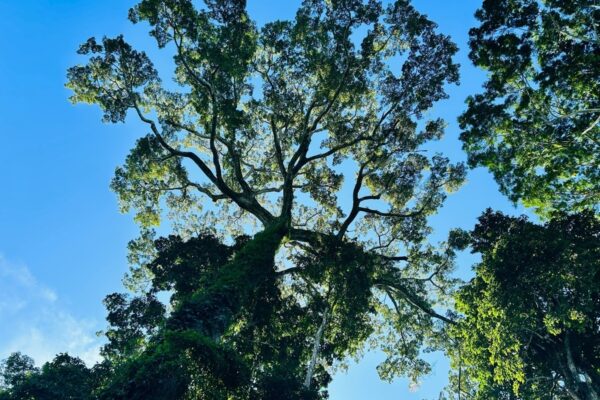In one of Ivory Coast’s largest remaining forests, many locals believe that conservation favours trees over people. Earthworm’s Félicie Forgeois reports on our work to change that perception by protecting livelihoods as well as forests, with some startling results.
Rainforests have disappeared faster in Ivory Coast than almost anywhere else in the world over the past 50 years. In that time, more than 80 pecent of the country’s forests vanished - and they’re still disappearing. In 2018, Ivory Coast suffered from the second highest increase in rainforest loss in the world after Ghana. Driving this destruction to a vast degree is cocoa, which Ivory Coast is the biggest producer of on the planet.
But while the scale of the problem is obvious, tackling it is fraught with complexities.
Central among them is how to relieve pressure on forests, without increasing it on people. How do you protect nature, while also protecting the livelihoods of the hundreds of thousands of smallholders; who dominate an industry that contributes around a tenth of the nation’s GDP? An estimated 35 percent of the Ivory Coast’s cocoa crop is grown illegally in national parks and forest reserves (Forêts Classées). Given this, how do companies with 'No Deforestation' commitments ensure that the cocoa they source is legally produced, without tacitly supporting the eviction of thousands of people who live and plant cocoa in protected areas?
There’s also another challenge - identifying precisely where deforestation is happening. So much cocoa production occurs in small areas under the cover of dense forest canopies, which farmers only destroy when the cocoa crops grow and require more sunlight.
Deep-seated challenges
Yet these problems are surmountable, as early results from a pioneering project in one of the Ivory Coast’s largest remaining forests show.
At 67,541 hectares, the Cavally Forest Reserve is one of the largest Forêt Classée in the west of Ivory Coast, and home to abundant - though dwindling - wildlife, including forest elephants and pygmy hippopotamuses.
The threats facing the Cavally Forest Reserve are typical of those faced by Ivory Coast’s remaining protected forests.
It lies in a region blighted by low development. For years, cocoa farmers - many of them migrants from Burkina Faso who fled drought or social upheaval - have encroached inside the reserve. Illegal deforestation driven by cocoa farming is rife, with much of it taking place under the forest canopy, which makes it hard to spot early from the air.
In November 2017, an attempt to resolve these deeply entrenched issues began; when a pilot project was launched by Airbus, Earthworm Foundation, SODEFOR (the government agency for forest reserves). The pilot used Starling satellite technology (developed by Airbus and Earthworm) to monitor deforestation and disturbances under the forest canopy in real time with 95 percent accuracy. This data was used to produce a base map, and increase patrols targeting illegal plantations.
Yet stopping illegal cocoa plantations without offering farmers alternative sources of income is like sweeping the homeless off the street without giving them somewhere to live.
The damage continues, but moves elsewhere.
Valuing forests over people
To prevent this from happening, the project expanded in July 2020, when Nestlé joined forces with Earthworm, SODEFOR and the Ministry of Waters and Forests (Ministère des Eaux et Forêts or MINEF) to invest USD 2.7 million in a three-year project to end deforestation in Cavally.
To protect and regenerate the forest, it was necessary to understand the needs of the people living there.
To that end, interviews were conducted with 755 locals from 66 villages. These gave granular detail on the forces propelling illegal cocoa farming in the area, as well as a vivid portrait of peoples’ lives.
The vast majority of locals (86 percent) don’t earn enough to meet their basic needs. And a quarter live below the national poverty line (€380 a year), with more women than men falling into this category. Basic health care is scarce, power shortages are common, and access to clean water is insufficient.
A lack of alternative employment and the quality of the soil within forests - where land is perceived as “free” and fertile - are the main reasons for cultivating cocoa in the reserve. The farmers sell their cacao beans to middlemen at average prices below those set by the state.
Beyond these specifics, many interviewees expressed a striking observation - that too often conservation projects value forests over people. Such a belief is hardly surprising in an area with limited development.
Sharp deforestation decline
The farmers were open to leaving the forest, if alternatives sources of income were available.
The next stage of the project, therefore, is working towards this. So that through consensus, productive well-run farms can be established outside the reserve.
There are also plans, among other things, for a tree-planting programme; for strengthening farmers routes and access to markets; for encouraging resilient farming practices; and establishing proper traceability for cocoa from the area.
All this is for the coming months and years. For now though, there has already been a startling decrease in the deforestation rate in the reserve - 21 percent between 2019 and 2020. This is largely due to Starling technology, which has led to more precisely targeted ground patrols.
Sustaining this over the long-term will require continuing to carefully balance local peoples’ interests with that of the land they’re custodians of.
While some lessons from the Cavally Forest Reserve project are specific and perhaps not replicable everywhere, the most important one certainly is.
It is that community engagement, and considering the needs of local communities, must be at the heart of the fight against deforestation, both in Ivory Coast, and around the world.


